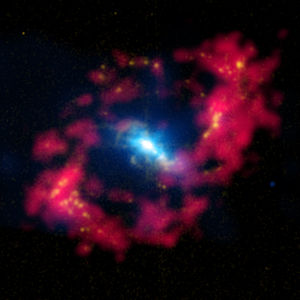- NGC 4151
-
NGC 4151 
NGC 4151. X-rays (blue), optical data (yellow), radio observation (red)Observation data (J2000 epoch) Constellation Canes Venatici Right ascension 12h 10m 32.6s[1] Declination +39° 24′ 21″[1] Redshift 995 ± 3 km/s[1] Type (R')SAB(rs)ab[1] Apparent dimensions (V) 6′.4 × 5′.5[1] Apparent magnitude (V) 11.5[1] Other designations UGC 7166,[1] PGC 38739[1] See also: Galaxy, List of galaxies NGC 4151 (or Eye of Sauron) is an intermediate spiral Seyfert galaxy located 43 million light years from Earth[2] in the constellation Canes Venatici, discovered by Frederick William Herschel on March 17, 1787. It is one of the nearest galaxies to Earth to contain an actively-growing supermassive black hole.[3]
Contents
X-ray source
X-ray emission from NGC 4151 was apparently first detected on December 24, 1970, with the X-ray observatory satellite Uhuru.[4]
HEAO 1 detected an X-ray source of NGC 4151 at 1H 1210+393, which is outside the Uhuru error box.[5]
A BL Lac object observed with the Einstein Observatory (1E catalog) within NGC 4151 is at 1E 1207.9+3945.[6] ROSAT detected the bright X-ray source in the NGC 4151 (20 Mpc) field: 1E 1207.9+3945 at RA (2000) 12h 10m 26.2s Dec (2000) +39° 29′ 03″.[6]
NGC 4151 is an X-ray landmark of the celestial sphere.
To explain the X-ray emission two different possibilities have been proposed:[2]
- radiation of material falling onto the central black hole (which was growing much more quickly about 25,000 years ago) was so bright that it stripped electrons away from the atoms in the gas in its path, and then electrons recombined with these ionized atoms
- the energy released by material flowing into the black hole in an accretion disk created a vigorous outflow of gas from the surface of the disk, which directly heated gas in its path to X-ray emitting temperatures
X-ray intensity
The X-ray luminosity (Lx) of the initial detection of an X-ray source (2U 1207+39) was ~1.1 x 1042 ergs/s (at a distance of 13 Mpc).[4]
X-ray source location
The X-ray source parallelogram (error box) for 2U 1207+39 stretches from ~1136+392 to ~1212+396.[4] Most of the error box is in the constellation Ursa Major (UMa).
See also
- X-ray astronomy
- Searching for the first X-ray source per constellation
- List of the first X-ray source in a constellation
- X-1 X-ray source
External links
References
- ^ a b c d e f g h "NASA/IPAC Extragalactic Database". Results for NGC 4151. http://nedwww.ipac.caltech.edu/. Retrieved 2007-03-27.
- ^ a b "The 'Eye of Sauron'". 2011-03-10. http://www.nasa.gov/mission_pages/chandra/multimedia/11-029.html. Retrieved 2011-03-14.
- ^ "NGC 4151: An active black hole in the "Eye of Sauron"". Astronomy magazine. 2011-03-11. http://www.astronomy.com/News-Observing/News/2011/03/NGC%204151%20active%20black%20hole%20in%20the%20Eye%20of%20Sauron.aspx. Retrieved 2011-03-14.
- ^ a b c Gursky H, Kellogg EM, Leong C, Tananbaum H, Giacconi R (Apr 1971). "Detection of X-Rays from the Seyfert Galaxies NGC 1275 and NGC 4151 by the UHURU Satellite". Ap J. 165 (4): L43–8. Bibcode 1971ApJ...165L..43G. doi:10.1086/180713.
- ^ Wood KS, Meekins JF, Yentis DJ, Smathers HW, McNutt DP, Bleach RD (December 1984). "The HEAO A-1 X-ray source catalog". Ap J Suppl Ser. 56 (12): 507–649. Bibcode 1984ApJS...56..507W. doi:10.1086/190992.
- ^ a b Warwick RS, Done C, Smith DA (Aug 1995). "The soft X-ray spectrum of NGC 4151 revisited". Monthly Notices of the Royal Astronomical Society 275 (4): 1003–16. Bibcode 1995MNRAS.275.1003W.
Categories:- Spiral galaxies
- Intermediate spiral galaxies
- Seyfert galaxies
- Canes Venatici constellation
- NGC objects
- UGC objects
- PGC objects
- X-ray astronomy
- Astronomical X-ray sources
Wikimedia Foundation. 2010.
